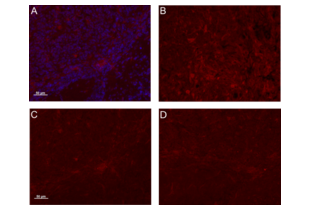Osteoactivin antibody (AA 81-180)
-
- Target See all Osteoactivin (GPNMB) Antibodies
- Osteoactivin (GPNMB)
-
Binding Specificity
- AA 81-180
-
Reactivity
- Human, Mouse, Rat
-
Host
- Rabbit
-
Clonality
- Polyclonal
-
Conjugate
- This Osteoactivin antibody is un-conjugated
-
Application
- Western Blotting (WB), ELISA, Immunofluorescence (Paraffin-embedded Sections) (IF (p)), Immunofluorescence (Cultured Cells) (IF (cc)), Immunohistochemistry (Paraffin-embedded Sections) (IHC (p)), Immunohistochemistry (Frozen Sections) (IHC (fro))
- Cross-Reactivity
- Human, Mouse, Rat
- Predicted Reactivity
- Cow,Pig,Horse,Guinea Pig
- Purification
- Purified by Protein A.
- Immunogen
- KLH conjugated synthetic peptide derived from human GPNMB
- Isotype
- IgG
-
-
- Application Notes
-
WB 1:300-5000
ELISA 1:500-1000
IHC-P 1:200-400
IHC-F 1:100-500
IF(IHC-P) 1:50-200
IF(IHC-F) 1:50-200
IF(ICC) 1:50-200 - Restrictions
- For Research Use only
-
- by
- Memorial Sloan-Kettering Cancer Center, Parada lab
- No.
- #100002
- Date
- 10/15/2015
- Antigen
- Osteoactivin
- Lot Number
- Method validated
- Immunohistochemistry (Formalin-fixed Paraffin-embedded Sections)
- Positive Control
- Tumor cell transplanted mouse brain was dissected
- Negative Control
- Notes
- The staining pattern was as expected for Osteoactivin as membrane protein.
- Primary Antibody
- ABIN749093
- Secondary Antibody
- Donkey-anti-Rabbit-Cy3
- Full Protocol
- Tumor cell transplanted mouse brain was dissected, fixed in 4% PFA for overnight, saturated in 30% sucrose, mounted in Cryo, and sectioned into 12µm sections.
- Immunostaining for Cryo Sections:
- Dry slides at 50-55°C for 15-30 min (or RT for 30min)
- Wash three times with PBS 5min (shake gently)
- Block with 10% Normal Donkey Serum (NDS) at RM for 1hour
- Incubate with primary antibody at 4°C overnight (Prepared in 2% NDS)
- Rabbit-anti-Osteoactivin antibody (ABIN749093) diluted 1:50-1:400
- Wash three times with PBS 5min (shake gently)
- Incubate with secondary antibody together with DAPI at RT for 1h (Prepared in 2% NDS), cover the chamber with foil
- Donkey-anti-Rabbit-Cy3
- DAPI 1:100
- Wash three times with PBS 5min (shake gently)
- Add three drops of water-based Immu-mount
- Cover with 24x60 cover glass
- Imaging
- Images were taken using a Zeiss Axio2-Imaging system, 20X-0.5NA-Dry Dye-1004-072 objective, DAPI and Cy3 channel.
- Experimental Notes
- ABIN749093 worked within the diution range 1:50 - 1:200; the antibody did not work well at a 1:400 dilution.
Validation #100002 (Immunohistochemistry (Formalin-fixed Paraffin-embedded Sections))![Successfully validated 'Independent Validation' Badge]()
![Successfully validated 'Independent Validation' Badge]() Validation ImagesFull Methods
Validation ImagesFull Methods -
- Format
- Liquid
- Concentration
- 1 μg/μL
- Buffer
- 0.01M TBS( pH 7.4) with 1 % BSA, 0.02 % Proclin300 and 50 % Glycerol.
- Preservative
- ProClin
- Precaution of Use
- This product contains ProClin: a POISONOUS AND HAZARDOUS SUBSTANCE, which should be handled by trained staff only.
- Storage
- 4 °C,-20 °C
- Storage Comment
- Shipped at 4°C. Store at -20°C for one year. Avoid repeated freeze/thaw cycles.
- Expiry Date
- 12 months
-
-
: "The glycoprotein GPNMB attenuates astrocyte inflammatory responses through the CD44 receptor." in: Journal of neuroinflammation, Vol. 15, Issue 1, pp. 73, (2019) (PubMed).
: "Osteoactivin (GPNMB) ectodomain protein promotes growth and invasive behavior of human lung cancer cells." in: Oncotarget, Vol. 7, Issue 12, pp. 13932-44, (2017) (PubMed).
: "Osteoactivin Promotes Migration of Oral Squamous Cell Carcinomas." in: Journal of cellular physiology, Vol. 231, Issue 8, pp. 1761-70, (2016) (PubMed).
: "Growth and repair factors, osteoactivin, matrix metalloproteinase and heat shock protein 72, increase with resolution of inflammation in musculotendinous tissues in a rat model of repetitive grasping." in: BMC musculoskeletal disorders, Vol. 17, pp. 34, (2016) (PubMed).
: "Differential expression of glycoprotein non-metastatic melanoma protein B (GPNMB) involved in trichostatin A-induced apoptosis in gastric cancer." in: International journal of clinical and experimental medicine, Vol. 7, Issue 12, pp. 4857-66, (2015) (PubMed).
: "Mutation in Osteoactivin Promotes Receptor Activator of NF?B Ligand (RANKL)-mediated Osteoclast Differentiation and Survival but Inhibits Osteoclast Function." in: The Journal of biological chemistry, Vol. 290, Issue 33, pp. 20128-46, (2015) (PubMed).
-
: "The glycoprotein GPNMB attenuates astrocyte inflammatory responses through the CD44 receptor." in: Journal of neuroinflammation, Vol. 15, Issue 1, pp. 73, (2019) (PubMed).
-
- Target
- Osteoactivin (GPNMB)
- Alternative Name
- GPNMB (GPNMB Products)
- Background
-
Synonyms: NMB, HGFIN, Transmembrane glycoprotein NMB, Transmembrane glycoprotein HGFIN, GPNMB, UNQ1725/PRO9925
Background: The protein encoded by this gene is a type I transmembrane glycoprotein which shows homology to the pMEL17 precursor, a melanocyte-specific protein. GPNMB shows expression in the lowly metastatic human melanoma cell lines and xenografts but does not show expression in the highly metastatic cell lines. GPNMB may be involved in growth delay and reduction of metastatic potential. Two transcript variants encoding different isoforms have been found for this gene. [provided by RefSeq].
- Gene ID
- 10457
- UniProt
- Q14956
-


 (6 references)
(6 references) (1 validation)
(1 validation)



